Ian Le Guillou finds that some of nature’s toughest structures are helping scientists to develop new fibres that could revolutionise fabrics
A conversation over coffee with a new colleague first piqued Darek Gorecki’s interest in limpet teeth. As a professor of molecular medicine whose research focuses on muscular dystrophy, it was far from his area of expertise, yet he was intrigued.
In 2015, limpet teeth replaced spider silk as the hardest known biomaterial. Its tensile strength – its ability to withstand stretching – is much greater and even comparable to carbon fibre and Kevlar. Trying to manufacture the tooth material would be very labour intensive, but Gorecki suggested making it by growing limpet cells in the lab.
‘I am a medic, but I was interested in whether I really would be able to pull this off,’ he says. ‘It was curiosity driven. As far as I was concerned, there was no practical application.’
After successfully managing to grow the cells and produce the super-strong fibrous material, he and his team at the University of Portsmouth in the UK are reconsidering that perspective. The unusual properties of the fibre could make it very useful indeed. ‘Given that this is a biodegradable, bioinspired material, its applications can be quite wide – from bioengineering to stab-proof vests,’ says Gorecki.
There is a growing demand for new materials that can replace the artificial fibres and components that pollute the environment. However, it is difficult to meet the requirements of both sustainability and durability. To create the materials of the future, scientists are drawing inspiration from the extraordinary structures found in teeth across the animal kingdom. From the depths of the ocean to our own mouths, teeth can tackle the toughest challenges in a variety of ways.
‘Millions of years of evolution have tuned the structure a lot better than anything we could come up with,’ says Florian Bouville, a materials scientist at Imperial College London, UK. ‘If you find a natural material that does the thing you want your material to do, it’s probably one of the most efficient structures you can make.’
Nightmarish vision
The toughness of a limpet’s teeth is a suitable match for its harsh existence. Spending its life firmly attached to a rock, the limpet continuously scrapes the stone to detach its diet of algae and microorganisms. Resembling a nightmarish vision from Salvador Dali, the teeth grow in a conveyor belt along the limpet’s tongue, known as a radula.

The millimetre-long teeth are mostly made of iron oxide in the form of goethite held in place by a scaffold of chitin, a polysaccharide that makes up the shells of many invertebrates, such as crabs and insects. ‘It’s an incredibly tough material. It’s got brilliant properties of high tensile strength and flexibility,’ says Robin Rumney, a post-doctoral researcher in Gorecki’s lab.
This composite structure of flexible framework and stiff minerals is widespread in nature, also appearing in our own bones and teeth. However, the high mineral content of the limpet tooth makes it far stronger.
Growing limpet radula cells in the lab, Rumney found they released enzymes into the surrounding liquid that encourage iron oxide to deposit onto chitin. Even once the cells are filtered out, the culture media remains a potent brew to incubate chitin and mineralise it to become extremely tough.
The resulting material is very similar to the limpet teeth, although minor differences in the arrangement of the fibres and size of the goethite crystals mean that it is not quite as strong. ‘We just managed to demonstrate that it’s possible to mimic this process to get material with similar properties,’ said Gorecki.
Making goethite synthetically in the lab takes about three days, heating the reagents in strong acid. By contrast, Rumney’s method takes two weeks but works at 14°C and an almost neutral pH. ‘Our process is a bit slower but requires far less energy because it’s been evolutionarily optimised by the limpets to work at sea temperature,’ he says.
Gorecki and his team are analysing the genetic activity of the cells to narrow down the enzymes involved. If they succeed, these catalytic proteins could be industrially produced, a simpler process than growing cells. They have already identified the enzymes that help to break down the chitin, potentially restructuring the fibres to prepare them for goethite deposition.
The material is currently just a proof of concept, with samples only half a centimetre wide. To scale it further, the team is trying to create the chitin fibres with less volatile solvents and developing collaborations to create larger sheets of the scaffold, up to the size of an A4 piece of paper.
One million tonnes of chitin is discarded each year as waste from seafood
With the small quantities produced so far, its hardness has only been measured using atomic force microscopy. It is only with larger pieces they can test the material with more typical mechanical means. ‘It’s very important to appreciate that when we scale it up, the mechanical properties can change quite dramatically. It doesn’t mean that they may not be useful, but they may be different,’ says Gorecki.
These bio-inspired materials can also meet the challenges of sustainability that plague many other fibres. Chitin is thought to be the second most abundant polysaccharide in nature, after only cellulose, with a billion tonnes produced in the biosphere each year. An estimated one million tonnes are discarded each year as waste from seafood, and Rumney hopes that this could be a plentiful source of material.
Self-healing materials
While limpets may take the crown for the strongest biomaterial, they are not the only sea creature with remarkable choppers. The teeth that line the suckers of squid tentacles could lead to new self-healing materials.
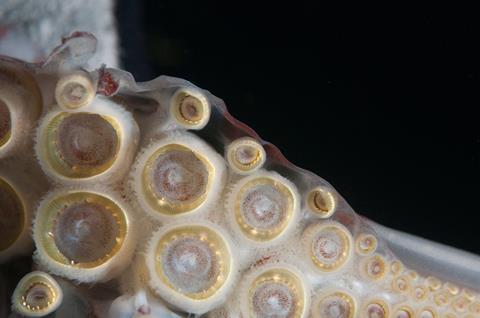
Used to bite prey, the squid ring teeth experience large, fluctuating compressive and shearing forces. To withstand this, the teeth are as hard as human bone while being as flexible as a fingernail.
Damage still occurs, but unlike our own teeth, these squid ring teeth can recover thanks to their unique makeup. The teeth are made of proteins with repeating patterns of certain amino acids that create a tight network of hydrogen bonds. These connections can break and reform repeatedly – the teeth can even be softened and reshaped in boiling water and regain their stiffness when cooled.
Melik Demirel, professor of engineering at Pennsylvania State University in the US, has studied these proteins for the last 10 years and set up a company to exploit their potential. Taking the squid genes responsible and inserting them into bacteria, he has created a pipeline for producing ring teeth protein fibres. ‘We now know how to do kilogram scale, but we don’t know how to make tonne scale yet,’ he says.
Demirel and his colleagues are still exploring the squid fibre’s many unusual properties, which could help determine future applications. For example, the fibre is highly triboelectric, meaning that it can build up a lot of static charge. This makes it well suited for trapping particles and Demirel has already built prototype filters using this material.
If we can make this thing cheaper, we can democratise the materials market
Another benefit of being derived from squid is that the ring teeth fibres are water resistant, unlike silk which can shrink. This opens up a range of applications, even including hernia repair. Demirel and surgical colleagues showed that a coating of squid ring teeth protein could improve the integration and strength of a plastic mesh for patching the abdominal wall in animal tests.
Demirel has much bigger markets in mind, such as clothing, hoping that a strong, self-healing, biodegradable and tuneable fabric could replace demand for synthetic material like polyester. However, the cost barrier remains a challenge. At the moment, the lab is mixing in less expensive cellulose-like materials to make it more economical. ‘If we can make this thing cheaper, we can democratise the materials market,’ he says. ‘If you want to invent a new material, it has to be cheap enough so that it can be distributed throughout the whole of society.’
Hidden layers
In addition to the tightly bonded parts of the squid ring teeth proteins that provide the hardness, there are also unstructured regions that make the teeth flexible. This balance of hard and soft is something that our own teeth have a solution for.
Tooth enamel is the hardest substance in the human body, thanks to the presence of large amounts of the mineral hydroxyapatite. This form of calcium phosphate is also found in bone, but in much lower quantities.
In enamel, hydroxyapatite exists as vertical rods that are held in place by a protein matrix. This makes it stronger than steel, but it has a downside. ‘If it was made entirely of this material, it would be very, very brittle,’ says Bouville.
The secret to preventing our teeth from shattering is the softer layer below, dentine. This subsurface material has less hydroxyapatite than enamel and forms horizontal rods of the mineral. ‘The layer below is more compliant and tougher, so if any crack grows in the enamel layer, it’s going to stop directly at the interface,’ says Bouville.
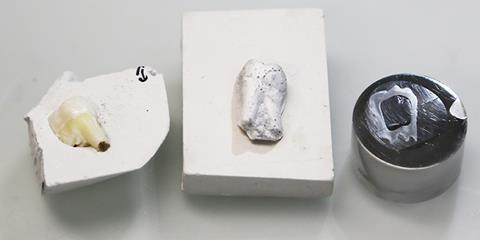
A similar type of bilayer strengthening is used for heavy-duty steel tools, for instance. Quickly heating and cooling the outer layer of the metal creates a disruption in the crystalline structure that makes it harder, while remaining supported by the softer inner layer.
Bouville and his colleague Hortense Le Ferrand, a materials scientist at Nanyang Technological University in Singapore, recreated a tooth-like bilayer structure using a magnetic field to align metal platelets. Using a mould to form the shape of a tooth, the team poured in a suspension of magnetised ceramic platelets and let it set to create the outer surface under the influence of a weak magnetic field. Once the outer layer was firm, they could repeat the process with an inner layer and a perpendicular magnetic field.
This magnetically assisted slip casting approach allowed the researchers to recreate a molar’s contours with a smooth surface. ‘That was probably the first time we were able to have a process where we could have a very complex outer shape and also locally control the orientation of the reinforcement,’ says Bouville.
Le Ferrand says this approach works well to prevent defects in the material. ‘You want to have it as tightly packed as possible, but when you get more concentrated, the particles start to interact. This led to the idea of using the slip casting method, where you have a dilute solution and concentrate it by removing the water.’
‘We could control the composition as well, so make it even more mineralised in the outer layer. And for the one inside, we could change the orientation of the reinforcement and the mineral content,’ says Bouville.
Teeth are the perfect example of something that would be very hard to reproduce
The team then cross-linked the platelets by soaking the tooth replica in acrylic monomers. The ensuing polymerisation in the structure acts as a mortar to hold the platelets together and gives it a similar strength to a real human tooth.
While Bouville and Le Ferrand could reproduce the shape of a molar and introduce a tough bilayer, the actual tooth structure is far more complex. ‘Teeth are the perfect example of something that would be very hard to reproduce, if we were trying to,’ says Bouville. ‘That’s why we call it bio-inspired and not bio-mimicking,’ adds Le Ferrand.
The team viewed this project as a proof-of-concept for manufacturing heterogeneous synthetic composite structures. This could allow many other biologically inspired materials to be created, including those based on nacre, or mother of pearl, a tough material found in some molluscs.
While the obvious use for a tooth mimic would be dental implants, Bouville doesn’t think that it would offer much of an advantage over existing ceramic ones. He did, however, work with a dentistry school to explore their use for training how to drill into the enamel without going through the dentine. ‘It’s really hard to get materials that have the same feel as an actual tooth. They always rely on tooth donations,’ he says.
Multiple applications
While such natural structures have been honed by evolution for their natural purposes, there is still plenty of scope for materials scientists to adapt them for new uses.
The biologically inspired layering of materials can have benefits beyond just strength. The magnetically assisted slip casting approach can also orient functional materials. For example, Le Ferrand has produced boron nitride composites that can efficiently conduct heat in specific directions, which could help to cool densely packed electronics.
It’s not just for one application, but more like a tool to do whatever you want
This magnetic alignment can also be combined with other manufacturing techniques like 3D printing. This is a form of bottom-up assembly that imitates the role of living cells in depositing materials during their growth, creating composite structures. Le Ferrand uses an approach that allows each drop, or voxel, to be only 200µm thick. This technique could allow a much greater level of complexity in the structure. ‘You can change the ink composition or the orientation in one voxel,’ she says.
As the ability to produce more complex structures develops, Le Ferrand hopes that machine learning will help to create new high-performance materials. Advances in the field are designing microscale constructions to meet the required attributes, placing components with different properties in a carefully fashioned 3D array. ‘It’s not just for one application, but more like a tool to do whatever you want,’ she says.
Until artificial intelligence is good enough to improve on natural materials, however, Gorecki and his team are experimenting with the limpet teeth fibres to alter their properties. This includes adding other minerals, inspired by the way that limpets take up metals that have polluted their waters, like nickel, aluminium or titanium. The fibre’s characteristics can also be tweaked through changes in the production process, like altering the thickness of the chitin or incorporating chitosan – a similar polysaccharide that is good for thermal insulation.
The squid-based fibres have even more scope for tuning thanks to the vast number of potential amino acid sequences of the proteins. Demirel has developed versions that are geared towards different abilities, making them tougher or heal more quickly, within seconds. By switching the charged groups in the proteins, he can tune the electrostatics of the filter for new purposes, for instance, in printers. The material can even be designed to alter its thermal conductivity depending on hydration. ‘What you expect from a fibre may not be the same as a filter. So, you have to use two different sequences and how you do that is the key question,’ he says.
We are surrounded by extraordinary natural materials with complex structures beyond our manufacturing ability. Few are more remarkable than teeth, highly specialised to face extremely tough conditions, bearing heavy loads to rip and crush without shattering. These biomaterials are a vast source of inspiration and will continue to bear fruit for many years to come. However, turning that inspiration into scalable, useable materials remains a challenge.
Reimagined manufacturing processes, whether a protein-producing bioreactor, recycling seafood waste or high-precision 3D printers, could offer the solution to creating a new generation of materials. There is a certain poetic justice that solutions to marine pollution could come from sea creatures themselves.
Just as the boom in synthetic fibres in the mid-20th century revolutionised the textile market, a new era of environmentally friendly, tooth-inspired materials could help society to become more sustainable. Perhaps we should look a gift horse in the mouth.
Ian Le Guillou is a freelance writer based in London, UK
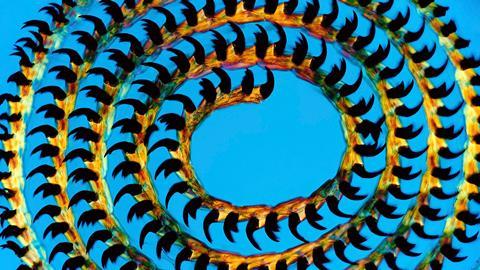
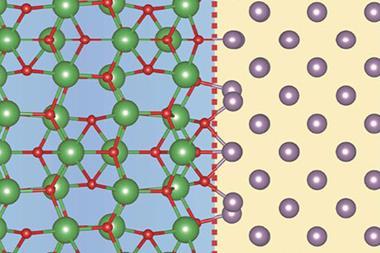


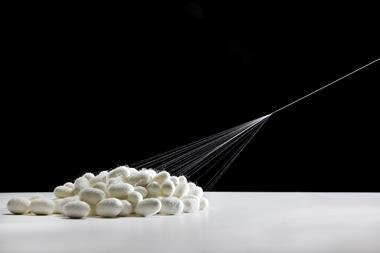
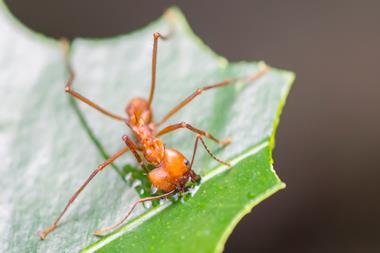
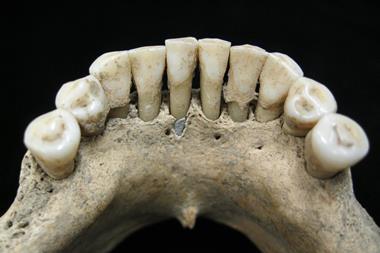






No comments yet